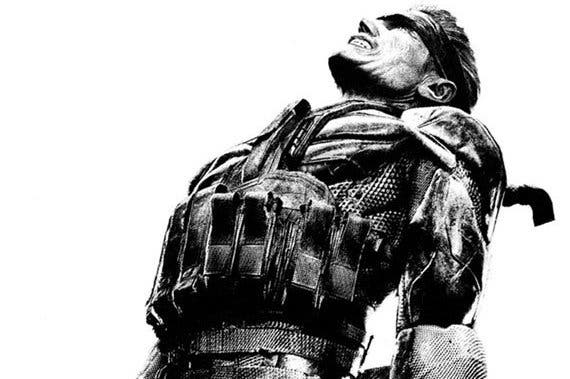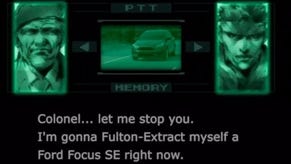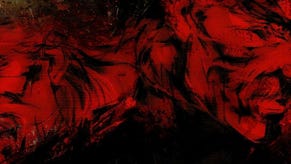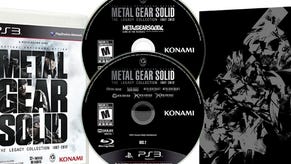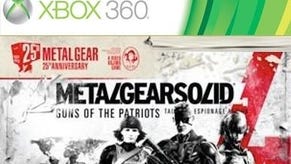Metal Gear Solid 4: Rinse, repeat, resolve?
The games industry strikes back.
Editor's note: many spoilers lie ahead for the entire plot of Metal Gear Solid 4.
Ever since the success of Metal Gear Solid, Hideo Kojima had avoided making the kind of sequel typical of the games industry. MGS2 intricately paralleled MGS with a self-reflexive structure that collapsed by design: the first postmodern video game. MGS3 avoided the problem entirely by being a prequel. But with Metal Gear Solid 4: Guns of the Patriots, the pressure was finally too much to bear.

Since the original's success and MGS2's spot of rug-pulling, many of the series' obsessive fans had demanded the return of favourite characters, especially Solid Snake - and now there was the added complication of MGS3's 1960s cast. MGS4 is where, for good and ill, Kojima stopped running from these expectations. On the surface, it gives the fans what they want to the point of fan-service, and ties up almost every loose end. But, as always with Kojima, there's a sting in the tail.
Solid Snake is back! As a pensioner. MGS4 is set in 2014, five years after the Big Shell incident of MGS2, but in that time-frame Snake's clone body has begun to rapidly age: he's 42 but looks in his 70s. This is probably not the return fans of the gruff special operative were hoping for, but it puts a powerful symbol front-and-centre of MGS4 throughout: an old man in a world changed beyond recognition.
Obviously, there are play-based limits to this, but Snake's failing body is emphasised repeatedly in his animations and in numerous small touches (a particularly great one is how easily he runs out of breath in the high altitude areas of Chapter 2). His state of mind is represented in-game by the Psyche meter, which lives below the health bar and is affected by everything from combat alerts to having a quick fag. When Snake's Psyche is low, his aim wobbles a lot more, and he'll even black out if it hits bottom.
Making this grizzled old chap a plausible action hero could have been a challenge, but it is achieved at a stroke with the dazzling Octocamo suit. This is an outfit worn by Snake that changes colour and pattern to blend in with the immediate surroundings, and brings everything great about MGS3's camo system while removing that game's menu busywork. Octocamo works automatically after Snake holds himself still against a wall or floor, allowing players to adapt on-the-fly, but the visual and audio implementation remain stunning. As Snake flattens against a surface, the suit's current pattern fades to black alongside SFX that mimics inhalation, pauses on black for a second, then blooms into the new texture with the sound of an exhalation. A game is born out of trying to squeeze Snake up against everything and find unusual patterns (which can be saved.) Even now, Octocamo takes the breath away: a lesson in how to reinvent a core mechanic with sumptuous style.
Old Snake also suits the role he has to play: "I'm no hero. Never was. Just an old killer hired to do some wetwork." Metal Gear has always been hypocritical about the military-industrial complex, presenting it as A Bad Thing narratively while breathlessly fetishising its hardware and trappings. MGS4 presents a world where the global economy has become dependent on warfare, specifically continuous civil wars fought by private military corporations (PMCs). These wars are not political but financial: military production and consumption is now what makes the world go round.
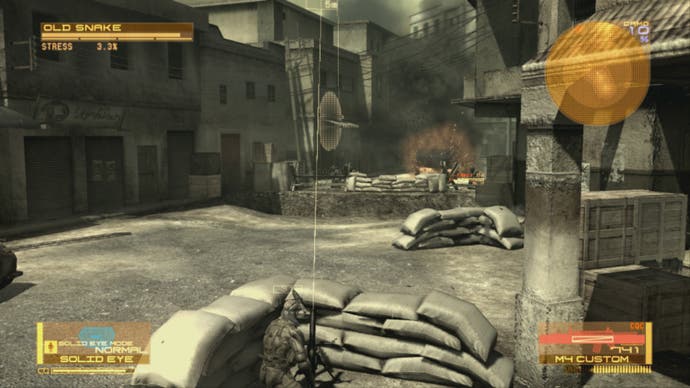
This war economy is the result of series uber-baddie Zero's Patriot AIs, systems that act on his principles but have no capability for judgement. These are behind the Sons of the Patriots system: nanomachines in the body of every soldier that track and regulate them, as well as every other aspect of modern war. In-game, this finds a neat expression in Drebin's gun shop, which allows Snake to 'unlock' ammo and weapons - but only by contributing to the war economy himself.
At this point, it's best to pull back from the nitty-gritty of MGS4's plot and look at what it does in a wider sense. I have a theory that Kojima had previously shied away from reusing characters because, in MGS, many of them are really symbols instead. An action game is not a great genre for complex or meaningful characterisation, and so MGS characters tend to embody a specific thing - whether that's an emotion, an ideology, or the player themselves. When such characters achieve resolution it is clean to the point of pat: Meryl realises she never wanted to be a soldier; Solid Snake realises there is more to life than being a soldier; Raiden realises he is his own man; Big Boss realises he is an unthinking weapon.
This context may explain why MGS4's major character-creation technique is combination. Almost everyone in this game is an amalgamation of others, even if only by proxy. The bosses are nicknamed the Beauty and the Beast unit, an all-female crew of 'beauties' traumatised by war. They are all chimera-like combinations of MGS bosses past. Laughing Octopus visually echoes MGS2's Solidus and uses his weapon, while sharing a codename with Decoy Octopus (MGS) and an emotion with the Joy (MGS3). Raging Raven combines Vulcan Raven, Fatman, and The Fury; Crying Wolf is Sniper Wolf, Fortune, and the Sorrow. I could go on, because beyond the obvious references are a wealth of incidental links.
The surface interpretation is that, in an era where "war has become routine", the emotional trauma that creates such damaged individuals has also become routine. The B&B unit may follow in the footsteps of the Cobras et al, but they are only humanised after death, and remain largely ciphers. The unavoidable implication is that Metal Gear Solid is becoming routine in a wider sense, too, worn down by the repetition inherent to sequels.
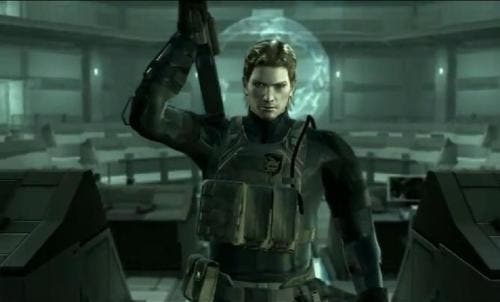
It's worth pausing over the concept of repetition, however, because the word has negative connotations that are too strong. All games are built on repetition, even if only of the player's capabilities. To be precise, conventional design depends on repetition-with-variation, creating the game's core mechanics and building a structure around them. The human mind adores learning and then mastering new skills, no matter how frivolous.
The core of MGS4's design is repetition-with-variation, not just to bring MGS's history to a climax but to make a point about the commercial video game formula. Kojima stitches together a parade of Frankenstein's monsters that re-enact classic scenes in their image. Raiden is first a mysterious codec voice warning of danger, like Gray Fox in MGS. He makes his first appearances saving Snake from danger, just as Gray Fox did, and we then see the prettyboy of MGS2 has become another chimera, a monstrously sleek fusion of nanotechnology and human flesh.
The repetition-with-variation goes much, much further. Raiden is now a proxy for the cyborg ninja, but the character was also a proxy for Solid Snake and the player to start with. The character stars in slightly-skewed repeats of MGS action sequences: he fights Vamp atop Metal Gear Rex, as Solid fought Liquid at MGS's climax; he loses his right arm saving Snake, just as Gray Fox did; he then 'dies' saving Snake from being crushed by Outer Haven, just as Gray Fox dies saving Snake from being crushed by Metal Gear Rex. Everything in the 'new' Raiden has an old source, and the character's existing meaning is overwritten as he is absorbed under the repetition.
This synthetic approach to characterisation shows, forcibly, that the future of a video game series is almost unbearably constrained by expectations from the past. This is not just a matter of changing locations, or era, or characters - all of which Kojima had tried before. The main promotional image for MGS4 showed Solid Snake, his body arched back in what looked like a scream of pain, with his lower half dissolving into tiny silhouettes of guns, items and characters. Snake's character is composed of his game history, and as a game character he is doomed to repeat himself.
The most direct manifestation of this theme is the fourth chapter's return to Shadow Moses, the setting for MGS. At the chapter's opening, MGS4 turns into an emulated version of the original game, a fun few minutes that are explained away as Snake daydreaming on the plane. On arrival at Shadow Moses, the nostalgia factor is off the charts, with the leap in fidelity and incredible snow effects going straight for the heart, helped along by old codec 'memories' scattered around. This repetition is exactly what some fans wanted: the return of classic Snake in a classic Metal Gear setting.
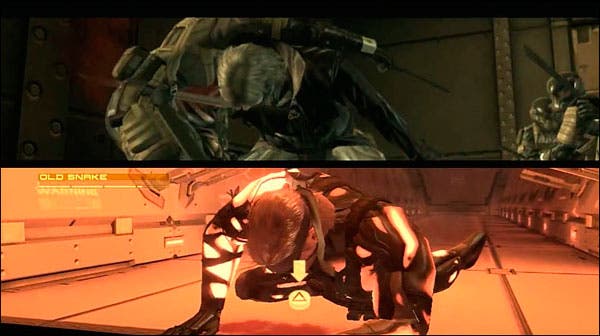
But this is no homecoming. Solid Snake is an old man, out of time, a 'normal' human being with no place on this nanomachine-led battlefield. And Shadow Moses, too, is old and decrepit, the familiar security systems rusted and useless. It turns out to be infested by robots that mimic the walking patterns of the original's soldiers, their limited sensing range mirroring the older game's reduced sightlines. It's one of the toughest stealth challenges in MGS4 despite this, bordering on frustration, which itself repeats the original's less forgiving nature.
The player has their role too - or some do, at least. MGS4 is often described as a game 'for the fans', which is too simple, but in this specific instance it is going for the gut of those who were there a decade ago. Two generations of console technology later, it is impossible not to look around this awe-inspiring recreation of Shadow Moses and reflect on the gap personally: I was around 16 when I played MGS, and this section of MGS4 was the madeleine that brought those memories rushing back. For each player, the level of introspection and impact will be individual, which for me makes Shadow Moses a conceptually perfect use of repetition.
MGS4 is far from a perfect game, however, and Shadow Moses is one reason why. The game's opening locations are large and detailed environments, with packed interiors, full of multiple routes and opportunities to play around. Whatever else the game is lining up in a narrative sense, it initially gets the balance between refining and updating the core MGS experience bang-on. Snake may be an old man but, in practice, he's still enormously capable and much more fluid to control than MGS3's Naked Snake (thanks largely to the addition of a crouch walk).
Problems arise when Kojima's narrative ambitions begin to encroach on and eventually smother the game underneath. The cut-scenes are a big problem, but cut-scenes can be skipped. From the third chapter onwards, however, objective and environment design become much more linear, often just bookending cut-scene after cut-scene. The narrative keeps pulling you forward, faster and faster, but the interactive elements start to be phoned in along the way.
Worse, stealth begins to be de-emphasised in favour of big set-pieces and half-baked variations, like tailing an enemy. MGS4's second half positively groans under the weight of mediocre on-rails shooting sections, pyrotechnic battles against multiple assailants, and deadening speechifying.
MGS4's second half positively groans under the weight of mediocre on-rails shooting sections, pyrotechnic battles against multiple assailants, and deadening speechifying.
There are exceptions: Metal Gear traditionally ends with a battle against one of the mechs, but like Snake, these machines are now relics. So as a replacement, we get a climactic battle between Solid Snake in Metal Gear Ray and Liquid Ocelot in Metal Gear Rex. Again, it's full of thematic repetition (not least in Solid getting the ostensibly weaker mech) but it's also just a clanking great throw-down of a fight, and enormous fun to play.
MGS4's actual climax is a fistfight between Solid Snake and Liquid Ocelot, which again mirrors the conclusion of MGS, but then begins to morph. The fight goes through four stages, and each channels a specific MGS: the characters' names change, the health bars change, and the movesets change to exactly mirror the originals. So you start with Solid Snake vs Liquid (MGS), then Solid Snake vs Liquid Ocelot (MGS2), then Naked Snake vs Ocelot (MGS3), and finally the UI is removed as the 'Old Snake' leitmotif begins to play. The fight encapsulates the theme beautifully, allowing players to feel and inhabit the fact that - while all the extraneous stuff may change - at the core of Metal Gear Solid is a cycle.
How does a series escape just repeating this stuff over and over? Kojima's answer is to wipe the slate clean by killing off almost every major character, and drawing closed the unrequited loop of the Snakes, doomed to fight among themselves on behalf of others. The Metal Gear games have always had the theme of parricide, setting sons variously against their biological father (Big Boss), their spiritual mother (the Boss), or the father figures they create (Raiden's Solid Snake). It is contagious: after meeting Big Boss during Operation Snake Eater, Ocelot becomes so obsessed he later adopts the identity of his dead son Liquid. Psycho Mantis talks about the 'trauma' of patricide he shares with Snake. The plot of MGS boils down to Liquid being pissed that he got dad's recessive genes (seriously). By MGS4, Solid Snake has killed his dad twice!
One of the great temptations with MGS as a series, especially now that Kojima's time with it is over, is to look upon their themes as autobiographical. Such interpretations are always on shaky ground but, regardless, it is hard to ignore that Hideo Kojima's own father died when he was a young boy. "I was just 13 when he died," Kojima told the Guardian. "It was hard and lonely but, in a way, it strengthened my resolve to become a filmmaker."
Kojima's first Metal Gear was made when he was 25, and MGS4 was released when he was 45. The final flourish on MGS4's closure is in healing the original father/son rift between Big Boss and Solid Snake - the only problem being that Big Boss is dead. MGS4 fakes out the ending at first, showing Solid Snake at the Boss's grave, getting ready to shoot himself - the only way out he can see.

Never mind that, says Kojima, as he blithely resurrects the father - and announces it through the ending credits. In this patchwork game, Big Boss comes back to life and is literally composed of the previous antagonists: his body is made up of parts from Liquid and Solidus, both of Snake's 'brothers,' and he's wearing the jacket of Gene, the main foe of Portable Ops. Over 10 minutes, this walking symbol CQCs Snake into happy submission, wheels out Zero and kills him, smokes a final cigar, drops the iconic MGS3 salute at the Boss's grave, and dies again.
This is absolutely crazy storytelling, but it gets to the heart of what Metal Gear had become, and what Kojima wanted to achieve with MGS4. Whatever faults it has, there is now very little room for future sequels to repeat Kojima's characters or themes. In essence, it's salting the Earth: giving the fans what they want only inasmuch as it guarantees they can never have it again. Of course, Konami could turn around and announce a Kojima-free game starring a younger Solid Snake; no doubt one day it will. But that character's arc and ending are now fixed forever.
In essence, it's salting the Earth: giving the fans what they want only inasmuch as it guarantees they can never have it again.
So MGS4 is a patchwork that, at times, doesn't quite work, but the conceptual genius of the whole demands attention. It is about how big video games sell us the same stories, in the same way, and change the window-dressing. It is about how creators that want to avoid repetition have to face the commercial reality that audiences demand repetition.
More than anything else, perhaps, it is about how our histories come to define us. Snake is pulled back into conflict because of his sense that the elements in play - Liquid, the Patriots - are part of his own makeup. There are regular 'flashback' moments where pressing X shows stills from MGS history superimposed over current events they parallel. There's the younger version of you, somewhere in that dream of Shadow Moses, and struck by countless other half-remembered references throughout.
Snake's ending is foreshadowed as suicide, from the title screen's gunshot to the penultimate cut-scene. But freed from all the baggage of his past, no more cycles, Solid Snake's final action is to lay down his gun. It is the most muted of triumphs: finally, with a few months to live, the 'old killer' has no more demons to slay.
Which leaves Kojima himself, the grizzled vet who created the wheels within wheels of the Metal Gear universe - and came back for one last job. With MGS4 he freed himself from expectation by ending all those expectations, delivering the sequel the fans said they wanted in the form of a funeral pyre.
There is a school of thought that Kojima 'deliberately' made MGS4 a bad game to emphasise whatever points he had in mind, which is obviously ludicrous. But if you want a video game blockbuster that deconstructs blockbuster design while using it, and is this close to success, MGS4 is well worth the repeat visit.
